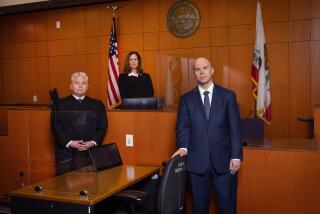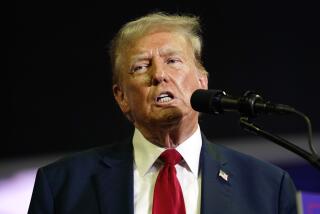Judge Bans Photos at Courthouse
SANTA BARBARA — A day before prosecutors planned to start picking members of a secret grand jury in entertainer Michael Jackson’s child-molestation case, a judge issued an order Wednesday threatening contempt charges if prospective jurors or witnesses were interviewed or photographed outside the courthouse.
The “decorum order” by Judge Clifford R. Anderson III, which declared that violators could be guilty of misdemeanors, raised the possibility of arrests if cameramen or photographers outside the courthouse even inadvertently photographed anyone who might be even a “prospective grand juror.”
Media attorneys promptly assailed the order as overly broad and blatantly unconstitutional. They asked Anderson, presiding Superior Court judge in Santa Barbara County, to immediately modify it while they prepared an appeal.
“It’s clearly unconstitutional to ban photographs outside the courthouse,” said USC law professor Erwin Chemerinsky, an expert on constitutional law. “I would love to represent anybody who was arrested for doing something like that, because they would have an extremely strong case.”
Jackson, 45, is free on $3-million bail on nine felony charges connected to the alleged molestation of a boy suffering from cancer at his Neverland Ranch in the Santa Ynez Valley last year. Prosecutors have selected the secrecy of a grand jury hearing over a public preliminary hearing as an initial step before any trial.
Sources have said that jury selection would begin today and that the first major witnesses against Jackson might testify as early as Monday or Tuesday. Among the first witnesses will be the alleged victim, now 14. The sources said testimony could last for up to two weeks, and that the grand jury might be moved around the county at times to minimize media coverage.
Anderson, noting that the convening of the grand jury has “created significant media and public interest,” specifically ruled that no witnesses would be allowed to talk about events in the grand jury room during the proceedings and that no photographs of prospective jurors, jurors or witnesses would be allowed inside or “while entering or exiting the courthouse” or any other facility or property used for the hearings.
The order is the latest move by the county to minimize what it fears could become a media circus over worldwide coverage of the Jackson case. Legal experts have characterized the county’s focus on secrecy as “obsessive.”
Theodore J. Boutrous Jr., representing a coalition of major media organizations, including The Times, wrote a letter to Anderson urging the judge to modify his order, saying any restrictions on photography inside or outside the courthouse would be unconstitutional and that grand jury witnesses had a “deeply ingrained” right to talk freely afterward.
Judge Rodney S. Melville, presiding over the case in Santa Maria, has issued a gag order on all parties, barring them from discussing any aspect of the case. In his letter to Anderson, Boutrous urged him to immediately modify his order until an appeal could be prepared.
Doug Mirell, a 1st Amendment lawyer in Los Angeles, called Anderson’s order “silly and unrealistic,” saying there was no way for media photographers to be able to tell who might be a prospective grand jury member in Santa Barbara County or, for that matter, who might be a witness.
“This latest order is an order ripe for challenge,” he said. “It doesn’t take into account the on-the-ground reality of everyday courthouse activity. This is a recipe for confusion and censorship.”
Selection of the grand jury is scheduled to start this morning, sources said. Nineteen grand jurors will be picked to hear the evidence away from the scrutiny of both the public and Jackson’s defense lawyers. It takes 12 jurors to decide whether charges should be filed. Grand juries usually do what prosecutors want them to do, legal experts say.
More to Read
Sign up for Essential California
The most important California stories and recommendations in your inbox every morning.
You may occasionally receive promotional content from the Los Angeles Times.










